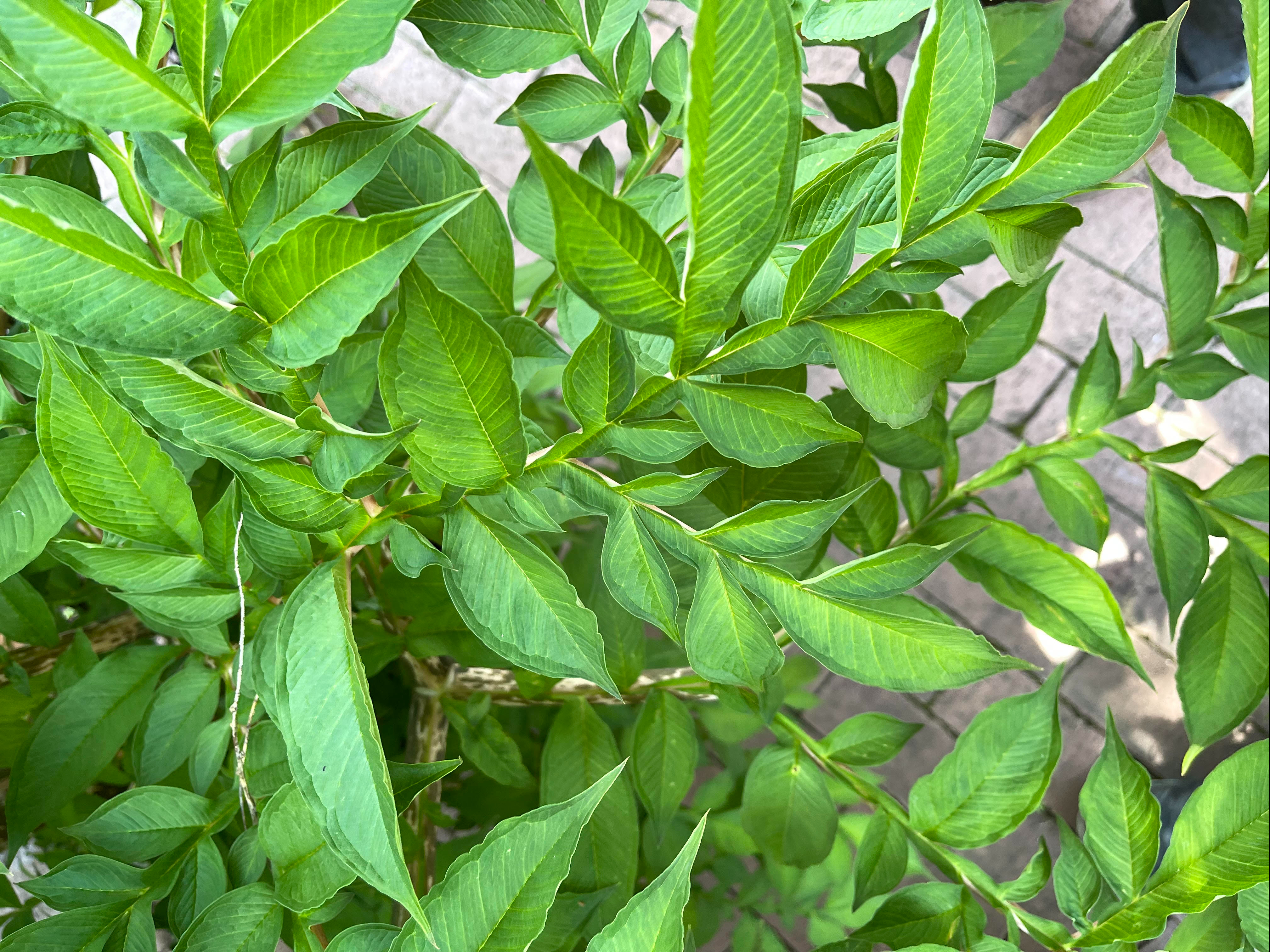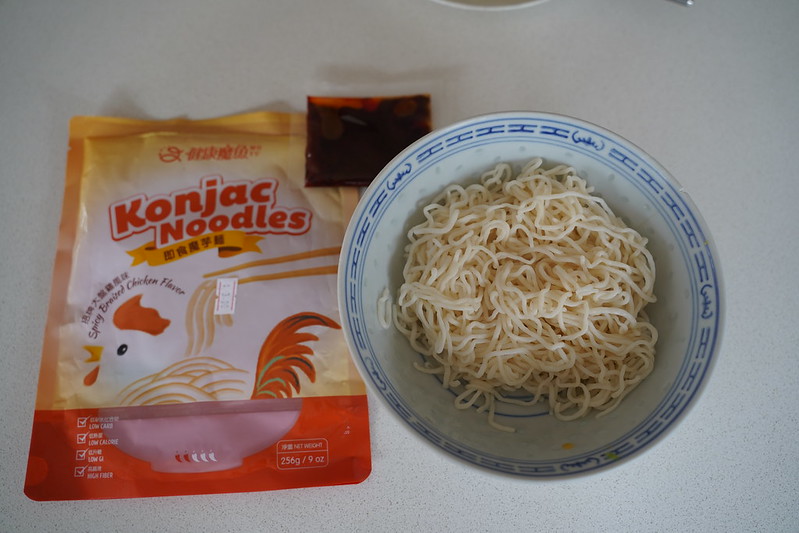by David McDaniel
A mass of compound-seeming leaves atop squishy stalks pouring out of a large pot in the central circle of the theme garden at the National Herb Garden was labeled “Devil’s Tongue.” Replanting was simple enough, and I did not think much about the plant after that. I figured it was a non-woody shrub of sorts. I recognize that the inability to categorize the plant into defined botanical terms should have tipped me off that it has an interesting life cycle, but it was not until I was making labels that I discovered just how interesting it is.
Amorphophallus konjac is a perennial corm in the Araceae family that grows a single, highly divided leaf, and once the corm reaches maturity it sends out a single inflorescence (Mahr, n.d.). The single leaf divides into the form of a small tree that serves to gather energy for the corm to either further maturity or regenerate after production of an inflorescence. The inflorescence has thousands of flowers at the base of the spadix within the spathe. The spathe is the part of A. konjac that wraps around the central spadix almost like a collar. The spadix is home to the inflorescence at its base and protrudes from the center of the spathe. The flowers are pollinated by carrion flies that are attracted to the smell of dead animals that emanates from the inflorescence (Mahr, n.d.). This plant is native to the Yunnan Province in China, but has become popular around the world for its unique culinary uses (Flora of China, n.d.).

The corm is an engorged stem base, shaped almost like a donut, that stores energy collected by the single leaf it sends up every year. The corm of the plant is edible, but cannot be consumed raw due to the formation of calcium oxalate crystals that cause intense discomfort in the mouth and digestive system (North Carolina Extension Toolbox, n.d.). The calcium oxalate crystals are broken down at baking temperatures; therefore, the peeled and sliced corm must be baked and then ground into a fine powder before it can be used (Fern, 2010).
 The powder, when combined with water, makes a jelly. The jelly is traditionally formulated with seaweed to give it a pleasant brine flavor. It is gray when seaweed is used in preparation but is white when prepared without. In Japan, the finished jelly product is called konnyaku, konjac (NC State Extension, n.d.). The English form of the word is pronounced like the liquor, cognac. The jelly takes on the flavor and color of any additional ingredients. Modern uses still have both traditional options, but fruit and vegetables are sometimes added for flavors used in candies and the bubbles in bubble tea. In bubble tea it is used as a replacement for tapioca when a sweet flavor, as opposed to a savory flavor, is desired. More generally, the jelly can be used as a vegan replacement for anywhere gelatin is used. It can also be used as a replacement for seafood. The seaweed preparation of konjac lends a fish flavor to dishes and is used as a vegan substitute for fish.
The powder, when combined with water, makes a jelly. The jelly is traditionally formulated with seaweed to give it a pleasant brine flavor. It is gray when seaweed is used in preparation but is white when prepared without. In Japan, the finished jelly product is called konnyaku, konjac (NC State Extension, n.d.). The English form of the word is pronounced like the liquor, cognac. The jelly takes on the flavor and color of any additional ingredients. Modern uses still have both traditional options, but fruit and vegetables are sometimes added for flavors used in candies and the bubbles in bubble tea. In bubble tea it is used as a replacement for tapioca when a sweet flavor, as opposed to a savory flavor, is desired. More generally, the jelly can be used as a vegan replacement for anywhere gelatin is used. It can also be used as a replacement for seafood. The seaweed preparation of konjac lends a fish flavor to dishes and is used as a vegan substitute for fish.
Another preparation of konjac is in the form of noodles. The noodles are translucent and are known as shirataki. Shirataki noodles are low calorie, gluten free, and light on carbs (Spritzler, 2018). Keto diet circles hail them as a “miracle food” since they are like wheat noodles, but are not as carbohydrate heavy or high in calories since they are 97% water and only 3% flour (Spritzler, 2018). The noodles can be substituted in recipes that have wheat noodles, provided some limitations are considered (Spritzler, 2018). The primary limitation is the lack of flavor when prepared on their own; however, the noodles will absorb a lot of flavor in the dish when cooked with other ingredients.
 The medicinal properties of konjac come from the glucomannan in the flour, as it is a source of good carbs for gut microbiota while not being available for uptake by humans (Spritzler, 2018). Feeding gut microbiota gives konjac prebiotic properties (Spritzler, 2018). The lack of bioavailability of the glucomannan is another reason konjac is popular in keto diets (Spritzler, 2018). The glucomannan also relieves constipation and symptoms of irritable bowel syndrome (Fern, 2010; Spritzler, 2018). The mechanism that allows glucomannan to work as such a good source of dietary fiber is that it has a high rate of water absorption by weight, which allows for a higher water content in bowel movements (Devaraj, 2019). The prebiotic properties are due to the preference of healthy bacteria native to the gut for glucomannan over other available sugars (Devaraj, 2019).
The medicinal properties of konjac come from the glucomannan in the flour, as it is a source of good carbs for gut microbiota while not being available for uptake by humans (Spritzler, 2018). Feeding gut microbiota gives konjac prebiotic properties (Spritzler, 2018). The lack of bioavailability of the glucomannan is another reason konjac is popular in keto diets (Spritzler, 2018). The glucomannan also relieves constipation and symptoms of irritable bowel syndrome (Fern, 2010; Spritzler, 2018). The mechanism that allows glucomannan to work as such a good source of dietary fiber is that it has a high rate of water absorption by weight, which allows for a higher water content in bowel movements (Devaraj, 2019). The prebiotic properties are due to the preference of healthy bacteria native to the gut for glucomannan over other available sugars (Devaraj, 2019).
The konjac at the National Herb Garden did not flower this year, but the leaves were large enough we had to plant it in the ground since it was bursting out of the pot. There’s a good chance in the upcoming years that it will flower brilliantly and I hope to see it. After reading about all of the uses of konjac I will be on the lookout for konjac foods and candies on my grocery trips!
Photo Credits: 1) The tree-like single compound leaf of Amorphophallus konjac (Sebastian Stabinger, via Wikimedia); 2) A group of A. konjac inflorescences, showing the collar-like spathe round the central spadix (James Steakley, via Wikimedia); 3) Close-up of the winged compound leaf (David McDaniel); 4) A packet of mango flavored konjac jelly (Open Food Facts); 5) Konjac noodles (Alpha, via Flicker)
Medicinal Disclaimer: It is the policy of The Herb Society of America, Inc. not to advise or recommend herbs for medicinal or health use. This information is intended for educational purposes only and should not be considered as a recommendation or an endorsement of any particular medical or health treatment. Please consult a health care provider before pursuing any herbal treatments.
References
Devaraj, R. D., C. K. Reddy, & B. Xu. 2019. Health-promoting effects of konjac glucomannan and its practical applications: A critical review. International Journal of Biological Macromolecules. 126: 273-281. Accessed November 6, 2022. Available from: https://pubmed.ncbi.nlm.nih.gov/30586587/
Flora of China (Internet). n.d. Amorphophallus konjac K. Koch, Wochenschr. Gärtnerei Pflanzenk. 1: 262. 1858. Flora of China. Accessed November 6, 2022. Available from: http://www.efloras.org/florataxon.aspx?flora_id=2&taxon_id=242302696
Fern, K. n.d. Amorphophallus konjac. Tropical Plants Database. Accessed November 6, 2022. Available from: https://tropical.theferns.info/viewtropical.php?id=Amorphophallus+konjac
Mahr, S. n.d. Voodoo lily, Amorphophallus konjac. Wisconsin Horticulture. Accessed November 6, 2022. Available from: https://hort.extension.wisc.edu/articles/voodoo-lily-amorphophallus-konjac/
North Carolina Extension Toolbox (Internet). n.d. Amorphophallus konjac. NC State Extension. Accessed November 6, 2022. Available from: https://plants.ces.ncsu.edu/plants/amorphophallus-konjac/#poison
Spritzler, F. 2018. Shirataki noodles 101. Healthline. Accessed November 6, 2022. Available from: https://www.healthline.com/nutrition/shirataki-noodles-101
David McDaniel is the National Herb Garden intern for the 2022-2023 season where he’s digging into the herbal uses of plants, as well as learning the ins and outs of public gardening.





